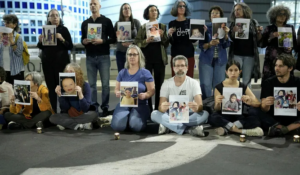Why Israel fears the faces of dead Palestinian children on its streets

Protesters hold photos of children killed in Gaza, during a protest in Tel Aviv on 19 April 2025
David Issacharoff writes in Haaretz on 21 April 2025:
Ahead of an anti-war demonstration scheduled for Thursday in Tel Aviv – organized by the Jewish-Arab movement Standing Together – the Israeli police said they would not allow the protest to take place unless organizers agreed to a ban on signs displaying images of “kids or babies from Gaza” or bearing references to “genocide and ethnic cleansing.”
The document outlining these conditions was riddled with grammatical and spelling errors, perfectly reflecting the heavy-handed police, who are acting without any clear guidelines or legal basis.
Even in death, Palestinian children killed by Israeli airstrikes in Gaza are treated as a threat in Israel. Signs bearing their faces “incite violent or illegal activity,” the police explained.
It was not only leftist activists who found these statements troubling. Staunch supporters of Israel’s fighting in Gaza – like Danny Orbach, a military historian from Hebrew University who often laments Hamas’ strategy of winning hearts and minds through victimhood and global pity – wrote on social media that, despite “deeply despising” Standing Together, the police’s actions represent a “severe and unjust infringement on freedom of expression.”
On Monday, Haaretz’s Josh Breiner reported that the police said they sent updated instructions to the protest’s organizers. Standing Together wrote on X that the police had backtracked on the conditions, and the movement told Haaretz that, in any case, they never planned to cave in to the demands.
Within the same 24-hour span, the ousted chief of the Shin Bet security service, Ronen Bar, revealed that Prime Minister Benjamin Netanyahu had ordered the domestic intelligence agency to spy on anti-government protesters more than once. Just another twisted episode in Israel’s dying democracy.
As for the police, Netanyahu doesn’t even need to give any explicit orders. The force has become a politicized body, shaped by the ethnonationalist Kahanist spirit of far-right National Security Minister Itamar Ben-Gvir.
Two days after Israel launched surprise strikes in Gaza – marking one of the deadliest nights since the war began and ending the cease-fire and hostage deal with Hamas – between March 17 and 18, a group of Israeli women took to the streets with pictures of children killed in the attacks, and Jewish memorial candles.
The group of a few dozen women got together in Tel Aviv after one activist posted an Instagram story, but they didn’t have enough participants to hold the images of the 183 Palestinian children reportedly killed that night.
The activist who organized this silent vigil near the weekly protest outside the defense ministry told Haaretz that she expected the verbal, at times sexually violent, smears by bystanders that they had usually encountered at their anti-war protests over the past year and a half.
This time, it was different. She said people stopped and watched. The silence, with nothing but the innocent faces of babies and children, seemed to have a distinct effect on those observing the demonstration.
After that, passersby asked to join. A WhatsApp group was created. From demonstration to demonstration, the group grew: From 30 to 100, then 200, and by last Saturday, around 300 people came to hold pictures of Gazan children. It’s also spreading to other cities – including Haifa, Umm al-Fahm, Jerusalem, and Jaffa, where a Palestinian group holds vigils. This movement is entirely spontaneous. The names and images come from “The Daily File” – a database put together by activist Adi Ronen Argov, tracking the names of Gazans killed each day.
The number of lives lost in Gaza during the war is of course no secret, but is treated as such by mainstream Israelis. Right-wingers see the number as justified. For centrists, like reservists signing petitions urging the war’s end, the number doesn’t exist. Only the Israeli hostages matter.
The anti-war activists holding the faces of the dead children in Gaza know that the fates of the hostages and the forsaken Palestinian children in Gaza – whose only apparent crime was being born in the enclave – are intertwined.
The police cannot suppress solidarity and empathy; quite the opposite: in their racist ineptitude, they might just end up amplifying it even further.
This article is reproduced in its entirety
